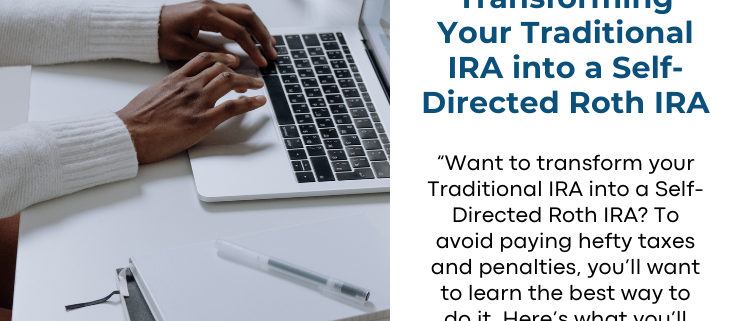Transforming Your Traditional IRA into a Self-Directed Roth IRA
It happens to a lot of people. They get started investing, believing that a Traditional IRA is the best way to put money aside for retirement. But then they hear about the benefits of the Roth IRA—including Self-Directed Roth IRAs—and want to change strategies. After all, a Roth IRA uses after-tax money, which makes it more flexible for additional options like not having to take required minimum distributions in retirement. And self-directing means you can access a wider range of investment asset classes, potentially boosting your returns.
Want to transform your Traditional IRA into a Self-Directed Roth IRA? To avoid paying hefty taxes and penalties, you’ll want to learn the best way to do it. Here’s what you’ll need to know.
Understanding How a Traditional IRA Can Become a Self-Directed Roth IRA
A Traditional IRA and a Roth IRA differ primarily in their tax treatment. Contributions to a Traditional IRA are typically tax-deductible, and you pay taxes on withdrawals during retirement. On the other hand, Roth IRA contributions are made with after-tax dollars, and qualified withdrawals are tax-free. A Self-Directed Roth IRA, however, adds an extra layer of flexibility. With self-direction, your Roth IRA can hold real estate investments, private notes, private stocks, and much more.
So why consider this transformation? It can be beneficial for several reasons. First, with a Roth IRA, your investments can grow tax-free. Second, by switching to Self-Direction, you can diversify your portfolio with non-traditional assets that may offer higher returns. And let’s not forget that qualified withdrawals from a Roth IRA are tax-free, which can be advantageous during retirement.
Steps to Transform Your IRA
Start by evaluating your current situation. You’ll need to do an assessment here. Look at your current Traditional IRA holdings and consider how a Roth IRA might benefit you. Consult with a financial advisor to understand the tax implications and benefits of making the switch.
Next, you’ll want to open a Self-Directed Roth IRA at a custodian like American IRA. We’re not saying you have to, but if you do weigh your options, choose a custodian who offers Self-Directed Roth IRA services. This custodian will manage your account. They’ll also help facilitate the transfer process. Ensure they provide access to a broad range of investment options.
Now it’s time to initiate a conversion. Contact your current IRA custodian to request a Roth IRA conversion. This process involves transferring your assets from the Traditional IRA to the Self-Directed Roth IRA. The conversion may trigger a tax event, so make sure you consult with your tax professional and plan accordingly.
The amount converted from your Traditional IRA to a Roth IRA will be subject to income tax. Prepare for this tax liability by setting aside funds or adjusting your tax payments.
Finally, once the conversion is complete, you can begin investing within your Self-Directed Roth IRA. This step means you can start diversifying your portfolio and exploring the wide range of investment opportunities now available to you. And since the Roth IRA has after-tax money in it, you don’t have to worry about your future tax liabilities when you make qualified withdrawals. It’s a lot of initial work that can result in decades of peace of mind.
Next Steps for Your Self-Directed Roth IRA
A Roth IRA provides all sorts of benefits, giving you the chance to invest in assets beyond traditional stocks and bonds. Utilize this flexibility. Feel free to build a diversified portfolio that aligns with your retirement goals. Once you do, you’ll be amazed at what you can accomplish.
Interested in learning more about Self-Directed IRAs? Contact American IRA, LLC at 866-7500-IRA (472) for a free consultation. Download our free guides or visit us online at www.AmericanIRA.com.







